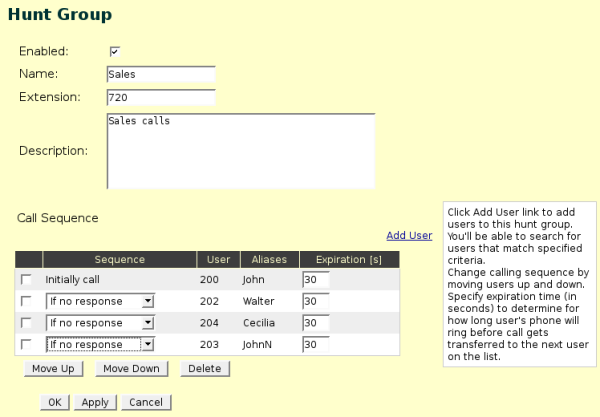Hunt Groups
A huntgroup is a virtual extension that triggers a calling sequence. If someone dials a huntgroup extension, sipXecs will execute a calling sequence programmed by the administrator. As a part of this sequence several real extensions can be called either simultaneously or sequentially (or some combination). The administrator has the option to specify how long each set of extensions should ring before moving to the next extension in the sequence.
The sipXecs system allows the addition of as many hunt groups as you need.
Configuration
To configure hunt groups go to the Hunt Groups screen and click on Add Hunt Group:
Enabled: The hunt group is only active if enabled using this check box (this allows you to configure the sequence without actually making it operational until you've finished setting it up).
Name: The name of the hunt group is similar to the User ID of a user and must be unique. A hunt group may be called either using its name or its extension (e.g. sip:myhuntgroup@domain.com).
Extension: A hunt group has a numeric extension that must be unique.
Configuring the Calling Sequence
The hunt group is configured as a sequence of calls to be made. Each call in the sequence is set to ring either
- at the same time, which means that it is called simultaneously with the call before it in the sequence
or - if no response, which means that the preceding call in the sequence is allowed to ring for its configured number of seconds
These can be mixed at different stages of a calling sequence so that one set rings, and then another set rings.
As soon as any user answers, the sequence is terminated. If two users being called at the same time both pick up, the first one will get the call.
Each sequence is called a "ringdown". It is not siggested to put more than 12 (twelve) devices in any ringdown sequence.
i.e. Call 200, 201,202 first 9this is a ringdown quantity of 3, which is fine), if no answer call 203, 204, 205, 206, 207, 208, 209, 210, 211, 212, 213, 214 (this is twelve and this is fine, more would result in unexpected or undesirable behavior). Even though 15 extensions are in the huntgroup, it acts on no more than "12" at any given time in the example above, and would be considered a proper configuration of a hunt group.
Any given user may only appear once to the calling sequence: adding the same user again will have no effect (the first instance is used, later ones are ignored).
You can create similar hunt groups by using the Duplicate button on the Hunt Groups screen.
Hunt groups are usable within a few seconds after you press the OK button. You can temporarily disable a hunt group without deleting it if you uncheck the Enabled checkbox and press OK.
Interaction with Voicemail
The hunt group call sequence will be followed until at least one user on the list answers the phone or the end of the sequence is reached. With the exception of the last user, the call will never be directed to any of the user's voicemail even if they have voicemail enabled. If 'Use Voicemail' is checked (default) the call will be directed to the voicemail of the last user. If 'Use Voicemail' is unchecked the call can be directed to an alternate destination (PSTN number, autoattendant, ACD line etc.).
Nested Hunt Groups Do Not Work
Nesting a hunt group does not do what you might think it would, and is not recommended.
Any time that you forward from a hunt group, the result essentially creates a new call with its own timeout sequence. Suppose you have a hunt group H that calls:
- A for 30 seconds
- B for 30 seconds, but B is also a hunt group set to ring:
- X for 60 seconds
- Y for 30 seconds
- C for 30 seconds
The result will be that A will ring for 30 seconds, then X will ring for 30 seconds, then C will ring for 30 seconds; Y will never be called. This is because the H hunt group only allows B 30 seconds - when that expires, the B call is cancelled.
